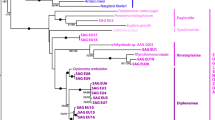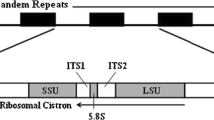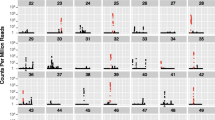Abstract
Because relatively little information is available about mtDNA in the euglenid protozoa, distant relatives of the kinetoplastid protozoa, we investigated mitochondrial genome structure and expression in Euglena gracilis. We found that isolated E. gracilis mtDNA comprises a heterodisperse collection of short molecules (modal size ~4 kbp) and that the mitochondrial large subunit (LSU) and small subunit (SSU) rRNAs are each split into two pieces. For the two halves of the SSU rRNA, we identified separate, non-contiguous coding modules that are flanked by a complex array of (primarily direct) A + T-rich repeats. The potential secondary structure of the bipartite SSU rRNA displays the expected conserved elements implicated in ribosome function. Label from [α-32P]GTP was incorporated in the presence of guanylyltransferase into each of the separate SSU and LSU rRNA fragments, confirming that these RNAs are primary transcripts, separately expressed from non-contiguous rRNA modules. In addition to authentic genes for SSU rRNA, we discovered numerous short fragments of protein-coding and rRNA genes dispersed throughout the E. gracilis mitochondrial genome. We propose that antisense transcripts of gene fragments of this type could have been the evolutionary precursors of the guide RNAs that mediate U insertion/deletion editing in the kinetoplastid relatives of the euglenids. To the extent that E. gracilis mtDNA is a representative euglenid mitochondrial genome, it differs radically in structure and organization from that of its kinetoplastid relatives, instead more closely resembling the mitochondrial genome of dinoflagellates in many of its features, an apparent evolutionary convergence.





Similar content being viewed by others

References
Avadhani NG, Buetow DE (1972) Isolation of active polyribosomes from the cytoplasm, mitochondria and chloroplasts of Euglena gracilis. Biochem J 128:353–365
Bendich AJ (1993) Reaching for the ring: the study of mitochondrial genome structure. Curr Genet 24:279–290
Bendich AJ (1996) Structural analysis of mitochondrial DNA molecules from fungi and plants using moving pictures and pulsed-field gel electrophoresis. J Mol Biol 255:564–588
Bendich AJ (2010) The end of the circle for yeast mitochondrial DNA. Mol Cell 39:831–832
Boer PH, Gray MW (1988) Scrambled ribosomal RNA gene pieces in Chlamydomonas reinhardtii mitochondrial DNA. Cell 55:399–411
Buetow DE (1989) The mitochondrion. In: Buetow DE (ed) The biology of Euglena, vol IV. Academic Press, San Diego, pp 247–314
Burger G, Gray MW, Lang BF (2003) Mitochondrial genomes—anything goes. Trends Genet 19:709–716
Cavalier-Smith T (1993) Kingdom Protozoa and its 18 phyla. Microbiol Rev 57:953–994
Cavalier-Smith T (1998) A revised six-kingdom system of life. Biol Rev 73:203–266
Cook JR, Roxby R (1985) Physical properties of a plasmid-like DNA from Euglena gracilis. Biochim Biophys Acta 824:80–83
Covello PS, Gray MW (1991) Sequence analysis of wheat mitochondrial transcripts capped in vitro: definitive identification of transcription initiation sites. Curr Genet 20:245–251
Covello PS, Gray MW (1993) On the evolution of RNA editing. Trends Genet 9:265–268
Cramer M, Myers J (1952) Growth and photosynthetic characteristics of Euglena gracilis. Arch Mikrobiol 17:384–402
Crouse EJ, Vandrey JP, Stutz E (1974) Hybridization studies with RNA and DNA isolated from Euglena gracilis chloroplasts and mitochondria. FEBS Lett 42:262–266
Donis-Keller H (1979) Site specific enzymatic cleavage of RNA. Nucleic Acids Res 7:179–192
Donis-Keller H, Maxam AM, Gilbert W (1977) Mapping adenines, guanines, and pyrimidines in RNA. Nucleic Acids Res 4:2527–2538
Dubin DT, Taylor RH, Davenport LW (1978) Methylation status of 13S ribosomal RNA from hamster mitochondria: the presence of a novel riboside, N4-methylcytidine. Nucleic Acids Res 5:4385–4397
Edelman M, Epstein HT, Schiff JA (1966) Isolation and characterization of DNA from the mitochondrial fraction of Euglena. J Mol Biol 17:463–469
Eperon IC, Janssen JWG, Hoeijmakers JHJ, Borst P (1983) The major transcripts of the kinetoplast DNA of Trypanosoma brucei are very small ribosomal RNAs. Nucleic Acids Res 11:105–125
Estévez AM, Simpson L (1999) Uridine insertion/deletion RNA editing in trypanosome mitochondria—a review. Gene 240:247–260
Feagin JE, Werner E, Gardner MJ, Williamson DH, Wilson RJM (1992) Homologies between the continuous and fragmented rRNAs of the two Plasmodium falciparum extrachromosomal DNAs are limited to core sequences. Nucleic Acids Res 20:879–887
Feagin JE, Mericle BL, Werner E, Morris M (1997) Identification of additional rRNA fragments encoded by the Plasmodium falciparum 6 kb element. Nucleic Acids Res 25:438–446
Fonty G, Crouse EJ, Stutz E, Bernardi G (1975) The mitochondrial genome of Euglena gracilis. Eur J Biochem 54:367–372
Gillespie DE, Salazar NA, Rehkopf DH, Feagin JE (1999) The fragmented mitochondrial ribosomal RNAs of Plasmodium falciparaum have short A tails. Nucleic Acids Res 27:2416–2422
Gray MW (2001) Speculations on the origin and evolution of editing, chap. 8. In: Bass BL (ed) Frontiers in molecular biology 34 (RNA editing). Oxford University Press, Oxford, pp 160–184
Gray MW, Schnare MN (1990) Evolution of the modular structure of ribosomal RNA, chap. 52. In: Hill WE, Dahlberg A, Garrett R, Moore PB, Schlessinger D, Warner JR (eds) The ribosome: structure, function, and evolution. American Society for Microbiology, Washington, pp 589–597
Gray MW, Schnare MN (1996) Evolution of rRNA gene organization, chap. 3. In: Zimmermann RA, Dahlberg AE (eds) Ribosomal RNA: structure, evolution, processing, and function in protein biosynthesis. CRC Press, Boca Raton, pp 49–69
Gray MW, Burger G, Lang BF (1999) Mitochondrial evolution. Science 283:1476–1481
Gutell RR, Larsen NL, Woese CR (1994) Lessons from an evolving rRNA: 16S and 23S rRNA structures from a comparative perspective. Microbiol Rev 58:10–26
Hajduk SL, Harris ME, Pollard VW (1993) RNA editing in kinetoplastid mitochondria. FASEB J 7:54–63
Hampl V, Hug L, Leigh JW, Dacks JB, Lang BF, Simpson AG, Roger AJ (2009) Phylogenetic analyses support the monophyly of Excavata and resolve relationships among eukaryotic “supergroups”. Proc Natl Acad Sci USA 106:3859–3864
Hassur SM, Whitlock HW Jr (1974) UV shadowing—a new and convenient method for the location of ultraviolet-absorbing species in polyacrylamide gels. Anal Biochem 59:162–164
Jackson CJ, Norman JE, Schnare MN, Gray MW, Keeling PJ, Waller RF (2007) Broad genomic and transcriptional analysis reveals a highly derived genome in dinoflagellate mitochondria. BMC Biol 5:41
Johnson DA, Gautsch JW, Sportsman JR, Elder JH (1984) Improved technique utilizing nonfat dry milk for analysis of proteins and nucleic acids transferred to nitrocellulose. Gene Anal Tech 1:3–8
Kajander OA, Rovio AT, Majamaa K, Poulton J, Spelbrink JN, Holt IJ, Karhunen PJ, Jacobs HT (2000) Human mtDNA sublimons resemble rearranged mitochondrial genomes found in pathological states. Hum Mol Genet 9:2821–2835
Keeling PJ, Burger G, Durnford DG, Lang BF, Lee RW, Pearlman RE, Roger AJ, Gray MW (2005) The tree of eukaryotes. Trends Ecol Evol 20:670–676
Krawiec S, Eisenstadt JM (1970a) Ribonucleic acids from the mitochondria of bleached Euglena gracilis. I. Isolation of mitochondria and extraction of nucleic acids. Biochim Biophys Acta 217:120–131
Krawiec S, Eisenstadt JM (1970b) Ribonucleic acids from the mitochondria of bleached Euglena gracilis. II. Characterization of highly polymeric ribonucleic acids. Biochim Biophys Acta 217:132–141
Leaver CJ, Harmey MA (1976) Higher-plant mitochondrial ribosomes contain a 5S ribosomal ribonucleic acid component. Biochem J 157:275–277
Lis JT, Schleif R (1975) Size fractionation of double-stranded DNA by precipitation with polyethylene glycol. Nucleic Acids Res 2:383–389
Lukeš J, Leander BS, Keeling PJ (2009) Cascades of convergent evolution: the corresponding evolutionary histories of euglenozoans and dinoflagellates. Proc Natl Acad Sci USA 106:9963–9970
Manning JE, Wolstenholme DR, Ryan RS, Hunter JA, Richards OC (1971) Circular chloroplast DNA from Euglena gracilis. Proc Natl Acad Sci USA 68:1169–1173
Marande W, Burger G (2007) Mitochondrial DNA as a genomic jigsaw puzzle. Science 318:415
Marande W, Lukeš J, Burger G (2005) Unique mitochondrial genome structure in diplonemids, the sister group of kinetoplastids. Eukaryot Cell 4:1137–1146
Maxam AM, Gilbert W (1977) A new method for sequencing DNA. Proc Natl Acad Sci USA 74:560–564
Nash EA, Nisbet RE, Barbrook AC, Howe CJ (2008) Dinoflagellates: a mitochondrial genome all at sea. Trends Genet 24:328–335
Nass MMK, Schori L, Ben-Shaul Y, Edelman M (1974) Size and configuration of mitochondrial DNA in Euglena gracilis. Biochim Biophys Acta 374:283–291
Peattie DA (1979) Direct chemical method for sequencing RNA. Proc Natl Acad Sci USA 76:1760–1764
Ray DS, Hanawalt PC (1965) Satellite DNA components in Euglena gracilis cells lacking chloroplasts. J Mol Biol 11:760–768
Schnare MN, Gray MW (1990) Sixteen discrete RNA components in the cytoplasmic ribosome of Euglena gracilis. J Mol Biol 215:73–83
Sloof P, Van den Burg J, Voogd A, Benne R, Agostinelli M, Borst P, Gutell R, Noller H (1985) Further characterization of the extremely small mitochondrial ribosomal RNAs from trypanosomes: a detailed comparison of the 9S and 12S RNAs from Crithidia fasciculata and Trypanosoma brucei with rRNAs from other organisms. Nucleic Acids Res 13:4171–4190
Small I, Suffolk R, Leaver CJ (1989) Evolution of plant mitochondrial genomes via substoichiometric intermediates. Cell 58:69–76
Spencer DF, Gray MW, Schnare MN (1992) The isolation of wheat mitochondrial DNA and RNA. In: Linskens HF, Jackson JF (eds) Seed analysis. Modern methods of plant analysis, new series, vol 14, Springer, Berlin, pp 347–360
Stoltzfus A (1999) On the possibility of constructive neutral evolution. J Mol Evol 49:169–181
Stuart K, Feagin JE (1992) Mitochondrial DNA of kinetoplastids. Int Rev Cytol 141:65–88
Stuart KD, Schnaufer A, Ernst NL, Panigrahi AK (2005) Complex management: RNA editing in trypanosomes. Trends Biochem Sci 30:97–105
Talen JL, Sanders JPM, Flavell RA (1974) Genetic complexity of mitochondrial DNA from Euglena gracilis. Biochim Biophys Acta 374:129–135
Tessier LH, van der Speck H, Gualberto JM, Grienenberger JM (1997) The cox1 gene from Euglena gracilis: a protist mitochondrial gene without introns and genetic code modifications. Curr Genet 31:208–213
Wahl GM, Stern M, Stark GR (1979) Efficient transfer of large DNA fragments from agarose gels to diazobenzyloxymethyl-paper and rapid hybridization by using dextran sulfate. Proc Natl Acad Sci USA 76:3683–3687
Waller RF, Jackson CJ (2009) Dinoflagellate mitochondrial genomes: stretching the rules of molecular biology. Bioessays 31:237–245
Yasuhira S, Simpson L (1997) Phylogenetic affinity of mitochondria of Euglena gracilis and kinetoplastids using cytochrome oxidase I and hsp60. J Mol Evol 44:341–347
Acknowledgments
This work was supported by an operating grant (MOP-4124) from the Canadian Institutes of Health Research (CIHR) to M.W.G.
Author information
Authors and Affiliations
Corresponding author
Additional information
Communicated by B. Franz Lang.
Electronic supplementary material
Below is the link to the electronic supplementary material.
Supplemental Figure R1.
Densitometry analysis to estimate the size of isolated Euglena mtDNA. Control and XbaI-cut Euglena mtDNAs were resolved on a 1% agarose, Tris-acetate gel. HindIII-cut λ DNA was included as a size marker. Densitometry of the ethidium bromide-stained was performed in ImageJ (Wayne Rasband, NIH) and the results are indicated beside the stained gel photo. From a calibration curve employing the λ DNA fragments, we estimate that the major fraction of uncut Euglena mtDNA is centered around 4 kbp while the minor, higher-molecular-weight fraction is centered around 7.5 kbp (as linear DNA). PDF 439 kb)
Supplemental Figure R2.
Photograph of agarose gel illustrating lack of detectable nucleolytic degradation of Euglena mitochondrial DNA preparations. Two fractions of Euglena mtDNA are shown: one fraction (lanes 1-7) clearly free of visible nuclear DNA as well the rRNA-encoding episome, the second (lanes 8-12) with small amounts of these contaminating DNAs present. The fractions were subjected to hydrolysis with various restriction endonucleases (cont = control untreated DNA) prior to gel electrophoresis. The higher-molecular-weight (genomic) DNA and the smaller 11.5 kbp episome serve as internal controls, supporting our conclusion that the observed condition of isolated Euglena mtDNA (heterodisperse collection of small molecules, most around 4 kbp in size) is not attributable to nuclease-mediated degradation. (PDF 2142 kb)
Supplemental Figure R3.
Northern hybridization analysis of Euglena mitochondrial RNAs. The left lane shows total Euglena mitochondrial RNA separated on a 6% denaturing polyacrylamide gel (4% crosslinking) and stained with ethidium bromide prior to capillary transfer to nylon membrane. The right-hand lanes are two exposures of the blot following hybridization with the ‘530 loop’ oligonucleotide that had been labeled at its 5′ end with [γ-32P]ATP and polynucleotide kinase. There is no evidence of any ‘full-length’ (i.e., spliced) small subunit rRNA (‘SSU’), which would be predicted to have a length of approximately 1100 nt. (PDF 738 kb)
Supplemental Figure 1.
Annotated E. gracilis mtDNA sequences. (A)XbaI fragment pEMX1-34 (rns-5′; GenBank acc. no. HQ266767); (B)XbaI fragment pEMX1-39 (rns-3′; GenBank acc.no. HQ266768); (C)XbaI fragment pEMX1-24 (no authentic genes; GenBank acc. no. HQ266766); (D)EcoRI fragment Y07965.1 (cox1) ; (E)EcoRI fragment AF156178.1 (cox2 + cox3). Arrows show the transcriptional orientations of genes and gene fragments and the relative orientations of flanking repeats. Upstream (UR) and downstream (DR) repeats are highlighted in yellow, with conserved inverted repeats underlined and color-coded in different shades of green. HindIII restriction sites within inverted repeats are shown as purple letters. Genes and corresponding gene fragments are highlighted in different colors: blue, 5′ coding region of the SSU rRNA (SSU-L); green, 3′ coding region of the SSU rRNA (SSU-R); red, cox1; orange; cox2; turquoise, cox3. Highlights in purple indicate blocks of LSU rRNA sequence. Gray highlight in (C) and (D) denotes non-coding sequences specifically conserved between these two clones. Translation initiation and termination codons are indicated by appropriately colored fonts on a white background. (PDF 3153 kb)
Supplemental Figure 2.
Proposed secondary structure of portions of the Euglena mitochondrial LSU-L and LSU-R rRNAs obtained by direct RNA sequencing. (A) GTPase domain within the 3′-terminal region of LSU-L. (B) α-Sarcin domain within 3′-terminal region of LSU-R. L5-1U, L5-1L, L3-1U and L3-1L denote the sequences of primers used in PCR amplifications (see text and Supplemental Fig. 4). (PDF 258 kb)
Supplemental Figure 3.
Alignment of upstream repeat, UR (A) and downstream repeat, DR (B) from XbaI clones pEMX1-24, pEMX1-34 and pEMX1-39. Identical residues are shown as white letters on a black background. Inverted repeats are indicated by colored underlining, with potential secondary structures shown on the right. ‘Egr Mt-L’ (A) and ‘Egr Mt-R’ (B) mark the sequences contained in PCR primers ‘L’ (5′-GTGATGAGGGTATCCTGAACGG -3′) and ‘R’ (5′-CATACAAAAACAATTAGGTATTGTAC-3′), respectively; see Supplemental Fig. 4. (PDF 222 kb)
Supplemental Figure 4.
Maps of six sequenced clones generated by PCR amplification employing primers to the most highly conserved regions of the UR (‘L’) and the DR (‘R’) (see Supplemental Fig. 3), a cox1 primer (‘cox9L’; 5′-CCRTATAATATACCTATTATYTTATG-3′), and four primers based on direct LSU rRNA sequence data and indicated in Supplemental Figure 2: L5-1U (5′-TCTAAGATTGATAGTATTCATGATA-3′); L5-1L (5′-TATCATGAATACTATCAATCCTAGA-3′), L3-1U (5′-GATTTATGTACGCAAGGATCAAATC-3′) and L3-1L (5′-GATTTGATCCTTGCGTACATAAATC-3′). The various repeats and identifiable gene fragments follow the coloring scheme employed in Figure 2 and Supplemental Figure 1, with larger colored terminal rectangles denoting the primer combinations employed. Clone designations are listed at the right of each map, with the length of each insert shown in parentheses. GenBank acc. nos. HQ266769 (L5-1U–R), HQ266770 (L3-1U–R(Top)), HQ266771 (L3-1U–R(Bottom)), HQ266772 (L–L5-1L), HQ266772 (L–L3-1L), HQ266774 (L3-1U–cox9L). (PDF 38 kb)
Rights and permissions
About this article
Cite this article
Spencer, D.F., Gray, M.W. Ribosomal RNA genes in Euglena gracilis mitochondrial DNA: fragmented genes in a seemingly fragmented genome. Mol Genet Genomics 285, 19–31 (2011). https://doi.org/10.1007/s00438-010-0585-9
Received:
Accepted:
Published:
Issue Date:
DOI: https://doi.org/10.1007/s00438-010-0585-9



